Page snapshot: Introduction to grass names, including scientific genus and species names, hybrid names, cultivar names, and trade names.
Topics covered on this page: Introduction; Why use scientific names?; Genus and species names; Rules for writing genus and species names; Infraspecific names; Rules for writing infraspecific names; Hybrid names; Hybrids between genera; Hybrids between species; Exceptions to hybrid names; Cultivar and trade names; Cultivar names; Trade names; Resources.
Credits: Funded by the National Science Foundation. Any opinions, findings, and conclusions or recommendations expressed in this material are those of the author(s) and do not necessarily reflect the views of the National Science Foundation. Page by Elizabeth J. Hermsen (2022).
Updates: Page last updated June 12, 2023.
Image above: Grains of pearl millet (Cenchrus americanus), one of a number of different grasses that are agriculturally grouped under the name "millet." Photo by Thamizhpparithi Maari (Wikimedia Commons, Creative Commons Attribution-ShareAlike 3.0 Unported license).
Introduction
Throughout this website, you will see both common names and scientific names for grasses. Common names are the names typically given to plants through common usage. These names do not necessarily have a traceable origin (although many do) and often cannot be credited to a single author (although some can). Names like big bluestem, large crabgrass, Kentucky bluegrass, Northern wild rice, and giant reed are all common names for grasses.
Scientific names are names that are given to plants by scientists using a formal naming process. Andropogon gerardii, Digitaria sanguinalis, Poa pratensis, Zizania palustris, and Arundo donax are scientific names that correspond to the common names listed above. Scientific names must be created following a series of rules outlined in the International Code of Nomenclature for Algae, Fungi, and Plants, which is updated on a regular schedule. Scientific names often (but not always) have their roots in Latin or Greek, and the forms that scientific names take is based on Latin.
This page provides a short summary of why we use scientific names (genus and species names) and how they are formatted, with examples taken from grasses. It also discusses hybrid, cultivar, and trade names, which are important to understanding the names of domesticated plants. For a more detailed discussion of scientific names across all of life, see the page: Digital Encyclopedia of Ancient Life: Taxonomy.
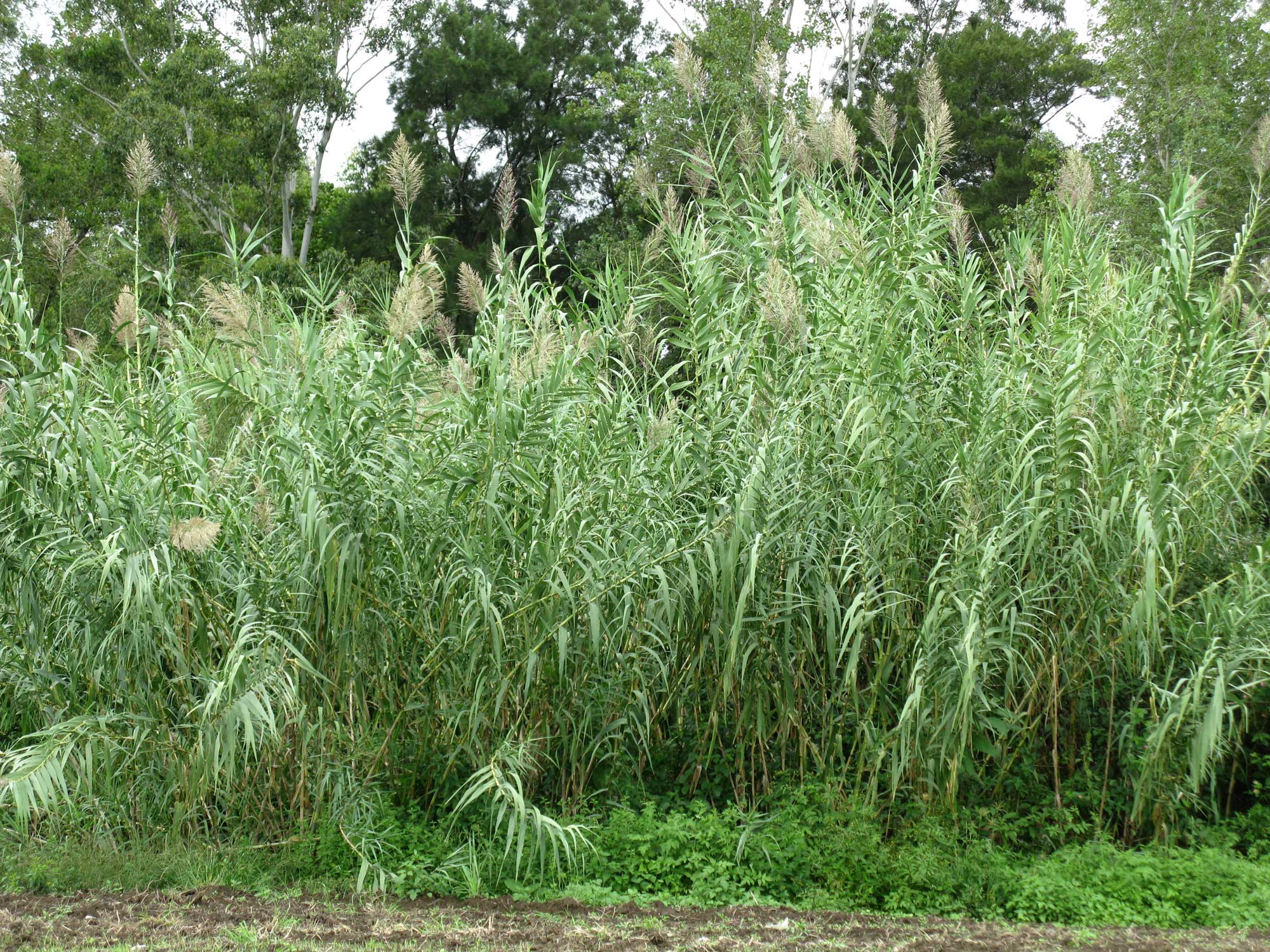
Giant reed(Arundo donax), New South Wales, Australia. Photo by Harry Rose (flickr, Creative Commons Attribution 2.0 Generic license, image resized).
Why use scientific names?
For most people, the common name of a plant is its more familiar name. So, why don't we just refer to plants using their common names? There are a variety of reasons to avoid common names when precision is necessary.
Firstly, plants may share a common name. A good example of this phenomenon is millet. A millet is a type of cereal (grass grain) crop that has relatively small grains. Millets come from several different species of plants, however, and some of them not closely related to each other. Thus, the term "millet" is not very precise.
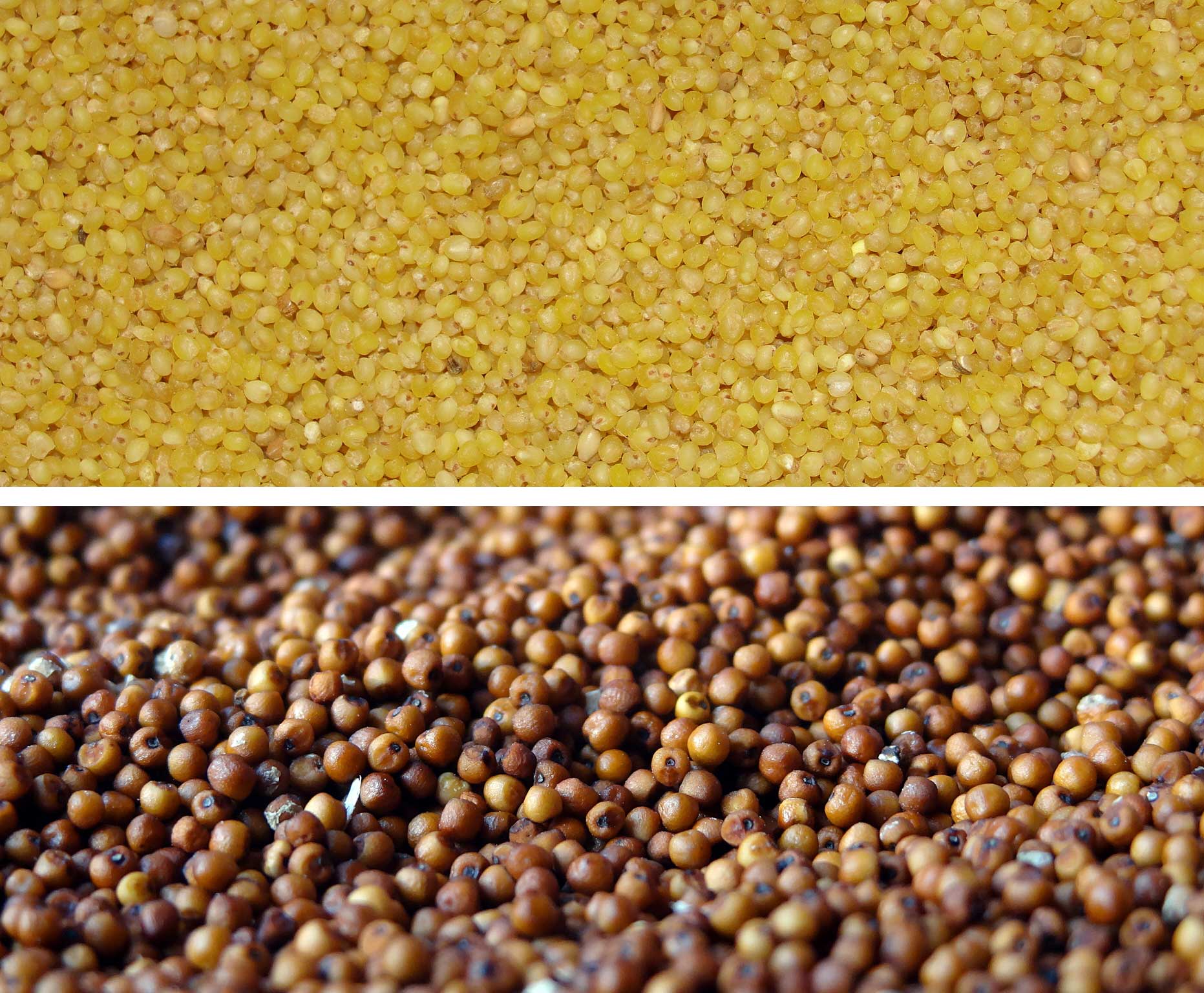
Grains of foxtail millet (Setaria italica, above) and finger millet (Eleusine coracana, below). These millets are from two different subfamilies of grasses. Upper photo by Thamizhpparithi Maari and lower photo by Aathavan jaffa (both photos via Wikimedia Commons, Creative Commons Attribution-ShareAlike 3.0 Unported license, images cropped).
Secondly, one plant may have more than one common name, even in a single language. This is especially true of plants that are widespread in distribution. For example, sorghum (Sorghum bicolor), a grass crop often grown for its grain, is also called great millet, milo, jowar, broomcorn, durra, or a variety of other names. Common names also differ across languages. For example, rice (Oryza sativa) is arroz in Spanish, riz in French, and dào (稻, referring to the plant) or báifàn (cooked rice) in Chinese.
In contrast, each species of plant has (at least in theory) one correct scientific name. While in practice things are messier (for example, scientists often disagree about which name is correct for a given plant if more than one scientific name has been proposed), international rules govern the process of scientific naming and applying scientific names. Additionally, scientific names remain the same across languages and cultures. Thus, no matter the region, language, culture, or even writing system used, the names Sorghum bicolor and Oryza sativa remain the same.
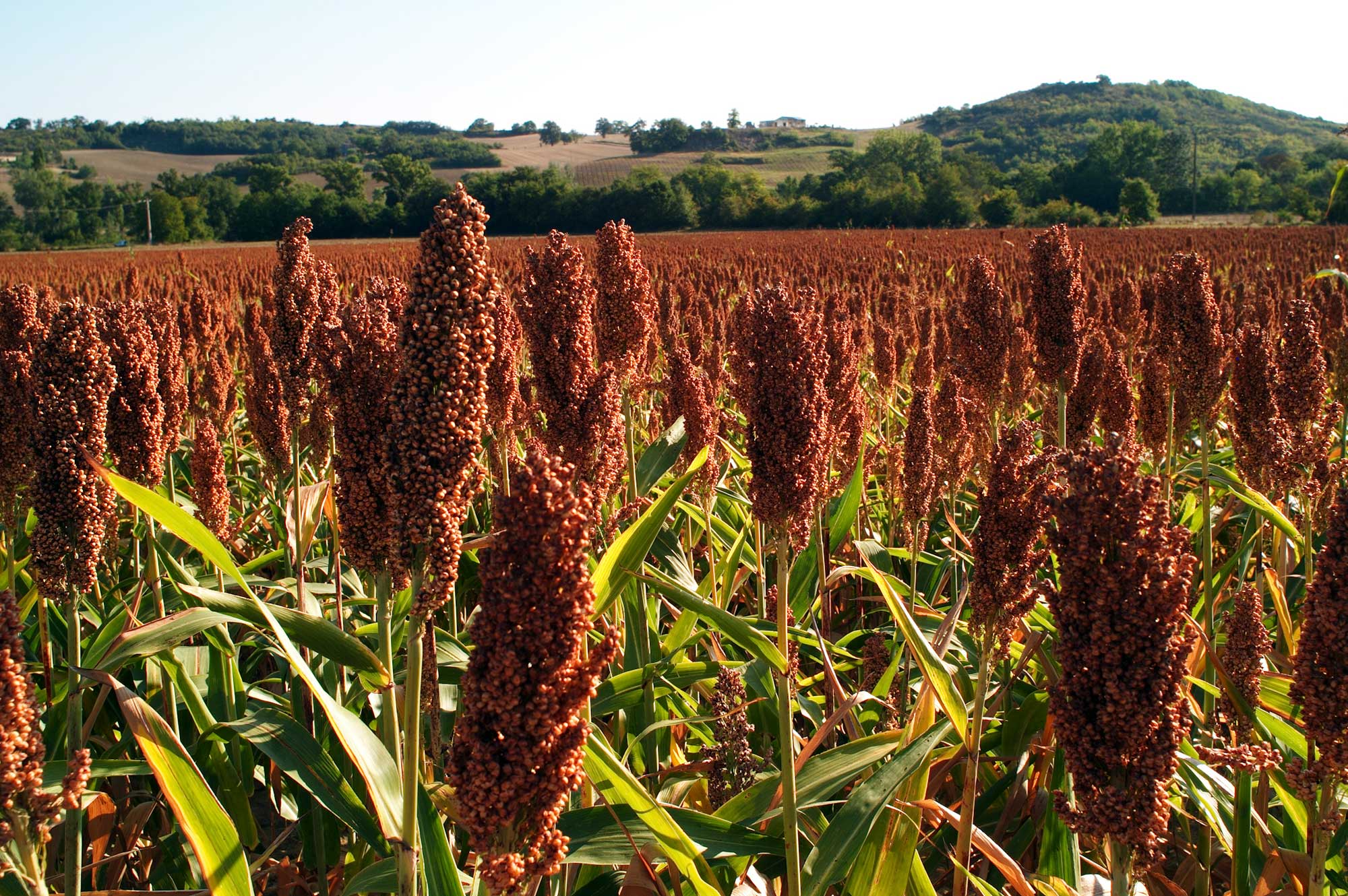
Cultivated sorghum (Sorghum bicolor), France. Photo by Jean Weber (flickr, Creative Commons Attribution 2.0 Generic license, image resized).
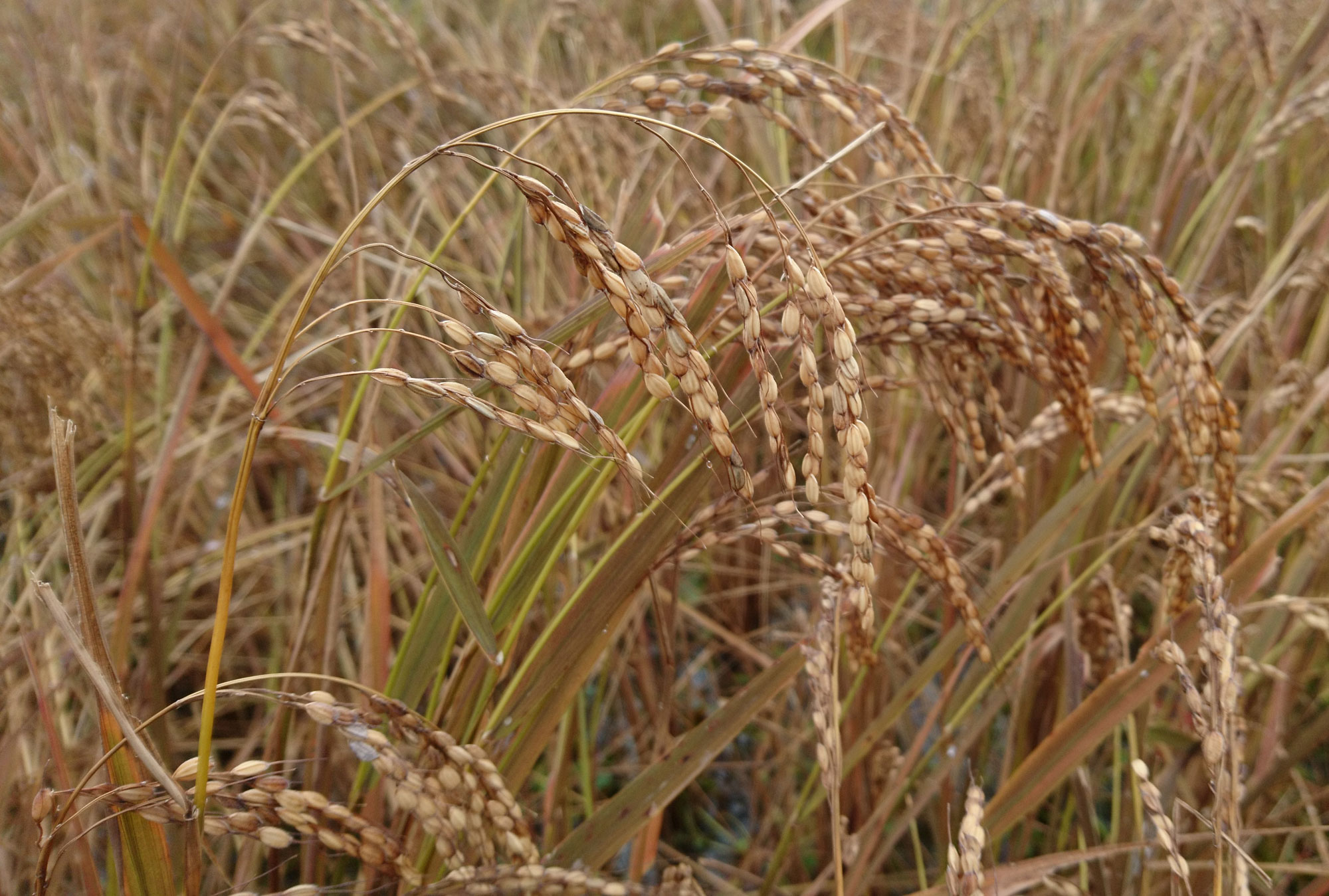
Cultivated rice (Oryza sativa), Japan. Photo by Sōseki no neko 漱石の猫 (Wikimedia Commons, Creative Commons Attribution-ShareAlike 4.0 International license, image cropped and resized).
Genus and species names
The precise definition of a species is a matter of some debate among scientists. In general terms, a species is a group of organisms that can interbreed with one another and produce fertile offspring, but cannot interbreed and produce fertile offspring with organisms from another species. In practice, this definition cannot always be strictly applied to plants, because plants from different species are sometimes able to interbreed and produce fertile offspring. In such cases, which group of plants makes up a species can be a matter of professional judgement.
A scientific species name is made up of two parts: a genus name and a specific epithet. A genus is a group of species that are more closely related to one another than they are to species in any other genus. There is no clear set of rules for how many plants should be included in a genus or what characteristics should unite the plants in a genus; instead, these are judgements left to scientists who specialize in plant naming and classification.
The genus names and specific epithets that make up plant species names often come from Greek or Latin, although they may come from any language. Sometimes, they many honor a person, refer to a geographic region, or even describe a characteristic of the plant itself. Regardless of the origins of the words that make up a scientific species name, the words in the name are Latinized, or written in the form of Latin words using the Latin alphabet. Genus names often end in -a, -us, or -um. Specific epithets may use these word endings or a variety of other endings, which vary depending on the gender (feminine, masculine, or neuter), number (singular or plural), and part of speech (for example, adjective or possessive noun) that a specific epithet represents.
As an example of a scientific plant species name, let us look at the scientific name of bread wheat or common wheat:
Triticum aestivum
The genus name, Triticum, simply means "wheat" in Latin. The species epithet, "aestivum," means summer in Latin. Thus, the scientific name of bread wheat means "summer wheat."
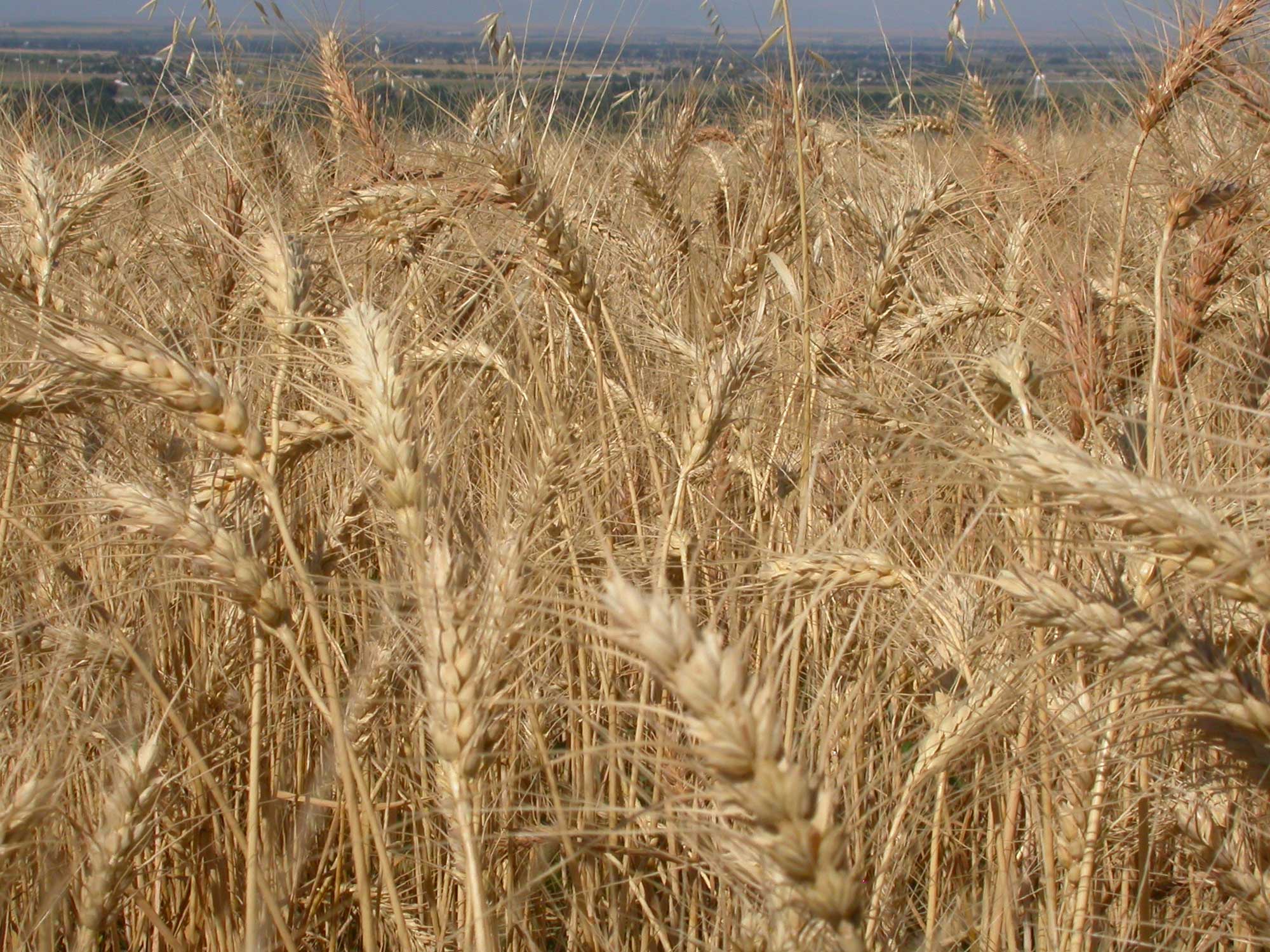
A field of bread wheat (Triticum aestivum) in Montana, U.S.A. "Triticum aestivum," Photo by Matt Lavin (flickr, Creative Commons Attribution-ShareAlike 2.0 Generic license, image resized).
Genus names are unique, meaning that two plant genera cannot share the same genus name. A specific epithet is an identifier that is unique to each species within a given genus, so two species in the same genus cannot share the same specific epithet. However, the same specific epithet can be used for species in different genera. For example, at least two species of cultivated grasses have the specific epithet sativa (Latin, meaning "cultivated," "planted," or "sown"): Asian rice (Oryza sativa) and common oats (Avena sativa).
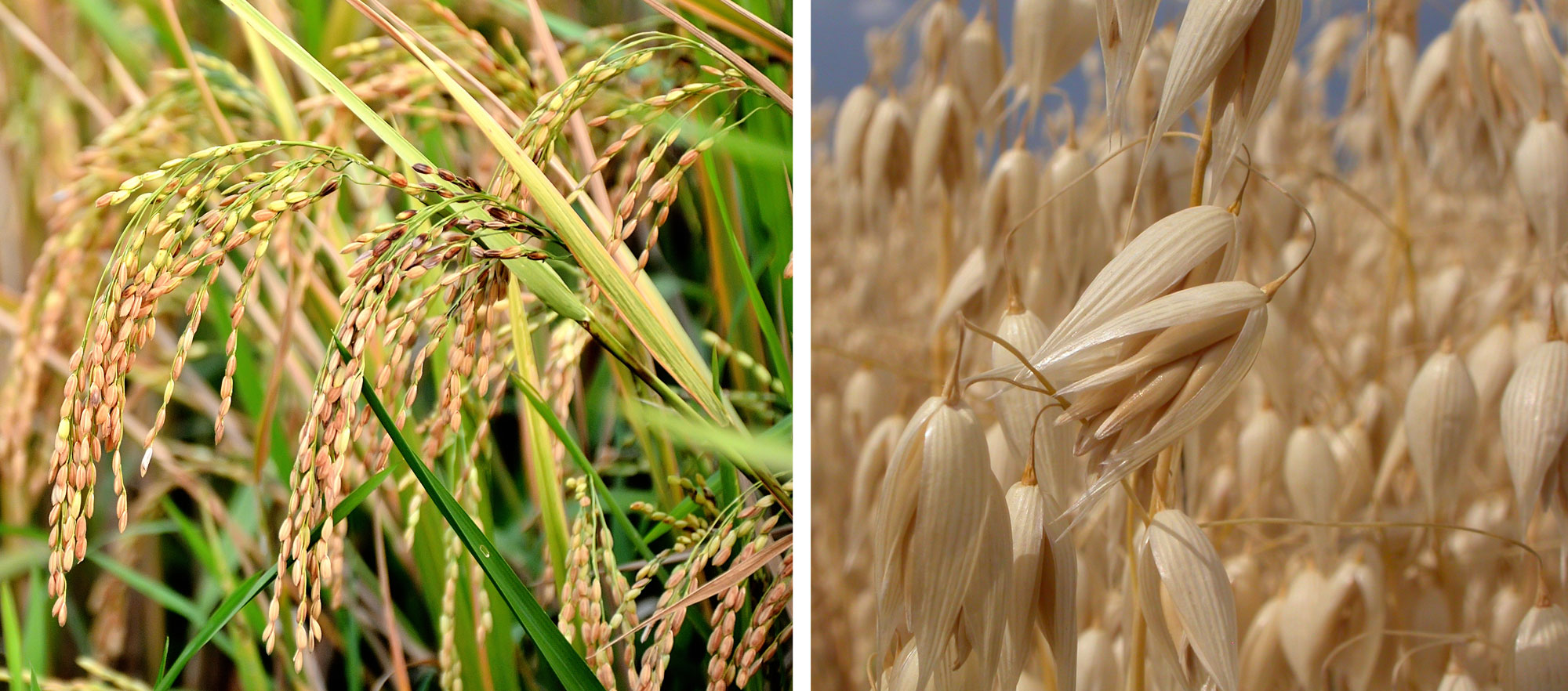
Left: Rice (Oryza sativa). Right: Oats (Avena sativa). Right photo by Augustus Binu (Wikimedia Commons, Creative Commons Attribution-ShareAlike 3.0 Unported license, image resized); left photo by Matt Lavin (flickr, Creative Commons Attribution-ShareAlike 2.0 Generic license, image cropped and resized).
Rules for writing genus and species names
Writing genus and species names correctly means following some rules, which are described below using Triticum aestivum (bread wheat) as an example:
Rules for genus names
- A genus name can be used alone when discussing all species in the genus at once. For example, Triticum can be used when discussing all species of wheat.
- The first letter in a genus name is always capitalized, whether it is followed by a specific epithet or not and whether it is abbreviated or not.
- Sometimes, the genus name and the common name for a plant are the same (for example, sorghum and Sorghum). In that case, which form to use (lower case and not italicized or upper case and italicized) depends on context.
Rules for species names
- The species name must always be written with both the genus name and the specific epithet. The specific epithet cannot be written without the genus name preceding it. For example, it is not correct to write aestivum.
- When writing a species name, the genus can be abbreviated using the first letter of the genus name followed by a period. Thus, the species name Triticum aestivum can correctly be written as T. aestivum.
- The specific epithet is always lower case, even if it is based on a formal name that would normally be capitalized.
Rules for both types of names
- Genus names and species names are always italicized. If italics cannot be used, underlining is an acceptable substitute: Triticum aestivum.
Infraspecific names
Sometimes, scientists name groups of plants below the rank of species, which are called infraspecific taxa (a taxon a formally named group of organisms at any rank). In descending order, taxa below the level of species are called subspecies, varieties, and forms. These ranks are optional; many if not most plant species are not divided into infraspecific taxa.
The name given to an infraspecific taxon is called an infraspecific epithet. An infraspecific epithet takes a form similar to that of a species epithet and likewise cannot be used on its own; it must be preceded by a species name.
As an example of an infraspecific name, let us look at durum wheat. Some scientists consider durum wheat to be its own species, Triticum durum. Others, however, consider it a subspecies, part of a complex of tetraploid wheats (wheats with four sets of chromosomes) in the species Triticum turgidum. When recognized as a subspecies, durum wheat is called Triticum turgidum subspecies durum.
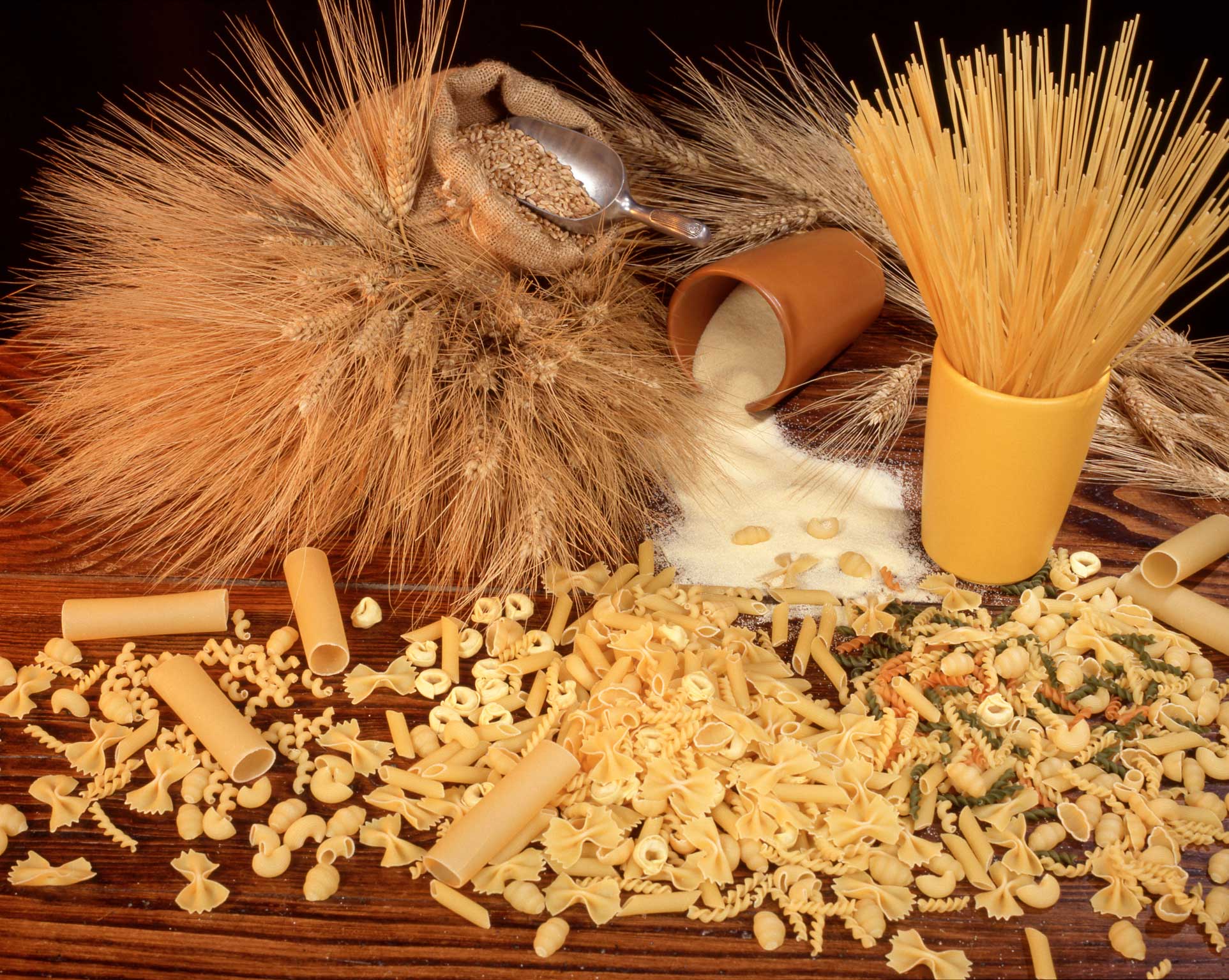
Durum wheat (Triticum turgidum subspecies durum) with pasta products made from durum wheat. Photo by Jean Weber (flickr, Creative Commons Attribution 2.0 Generic license, image resized).
Rules for writing infraspecific names
Writing the names of subspecies, varieties, and forms correctly means following some rules, which are described below.
- The infraspecific name must always be written following the species name. The infraspecific epithet cannot be written without the species name preceding it. (However, a species name may be written without an infraspecific epithet when discussing all members of a species.)
- The rank (subspecies, variety, or form) of the infraspecific name should be indicated between the species epithet and the infraspecific epithet. The rank may be abbreviated (for example, subsp. for subspecies).
- The infraspecific epithet is always lower case, even if it is based on a formal name that would normally be capitalized.
- The infraspecific epithet is always italicized. If italics cannot be used, underlining is an acceptable substitute.
Hybrid names
A hybrid is a cross between lineages or groups of plants. A hybrid plant, for example, could have parent plants that come from two different species in the same genus or even two different genera. Hybrids can occur naturally in grasses, although humans also create hybrids by intentionally breeding plants from different groups.
Hybrids between genera
Hybrids can have parents from two different genera. Hybrids between genera can be represented by a hybrid formula. In a hybrid formula, the names of the parent genera are separated by a multiplication sign (a letter "x" can be substituted if a true multiplication sign is not available). Typically, the names are written in alphabetical order. For example, the hybrid formula for triticale, a man-made hybrid crop made by crossing wheat (Triticum) and rye (Secale) can be written:
Secale x Triticum
A hybrid genus can also be written using a unique nothogenus name, which is preceded by a multiplication sign. (The prefix "noth-" nor "notho-" derives from Greek nothos, and indicates a hybrid.) The nothogenus name is made using a combination of the genus names of a hybrid's parent genera. The nothogenus name for triticale is:
x Triticosecale
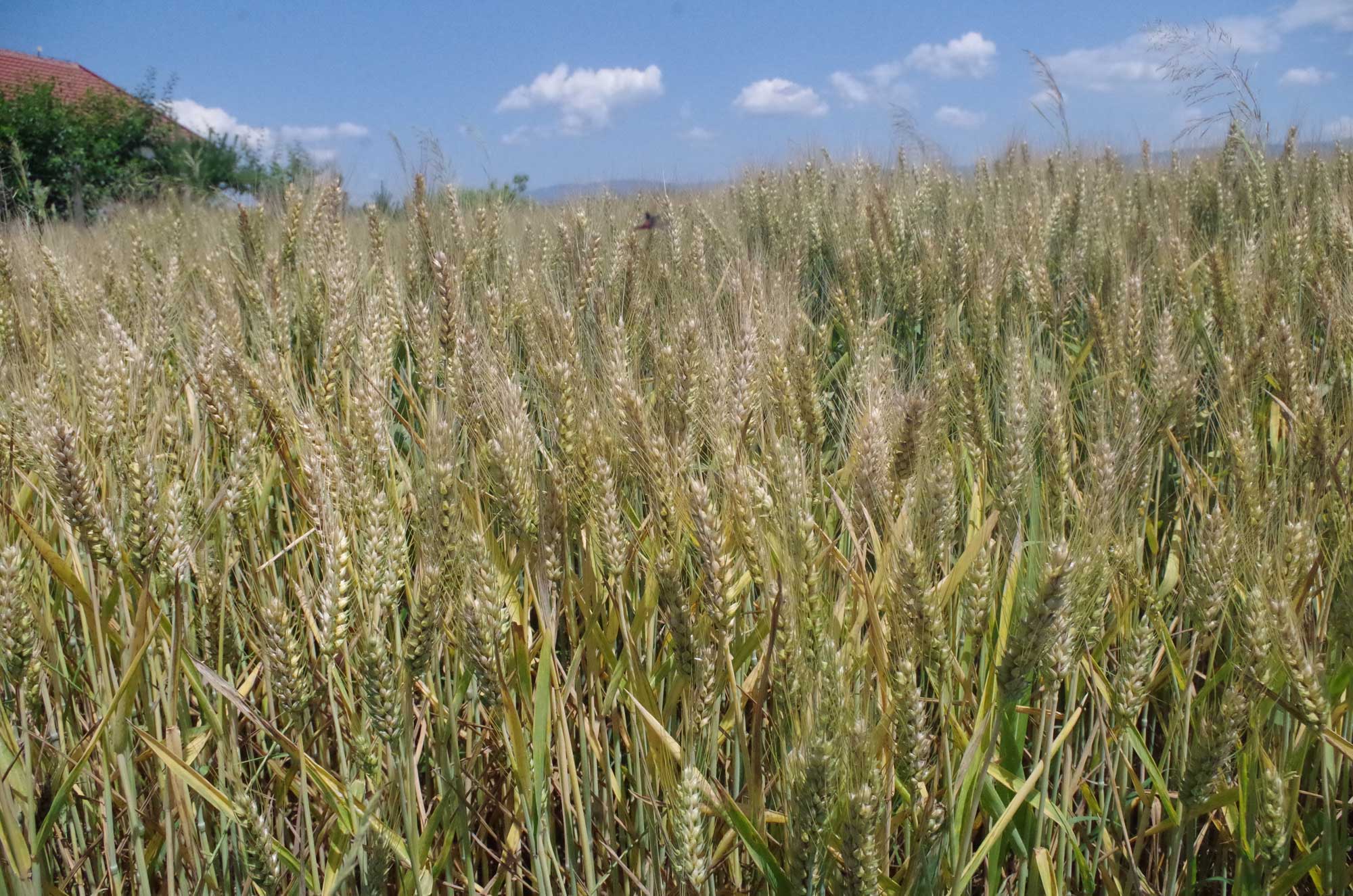
A field of triticale (Tritcosecale) in Macedonia. Photo by Македонец (Wikimedia Commons, Creative Commons Attribution-ShareAlike 4.0 International license, image resized).
Hybrids between species
Hybrids between species in the same genus can also be represented by a hybrid formula, with species names of the parent plants written in alphabetical order and separated by a multiplication sign. For example, Chinese sugar cane, a hybrid of cultivated sugar cane (Saccharum officinarum) and wild sugarcane (Saccharum spontaneum), can be written using the hybrid formula:
Saccharum officinarum x Saccharum spontaneum
Hybrids may also be given their own unique nothospecies names, which include a novel nothospecies epithet, called a collective epithet. A nothspecies epithet does not have to come from or be related to the species epithets of the parent species. In a nothospecies name, a multiplication sign is placed before the nothospecies epithet. For example, the nothospecies name for Chinese sugar cane is:
Saccharum x sinense
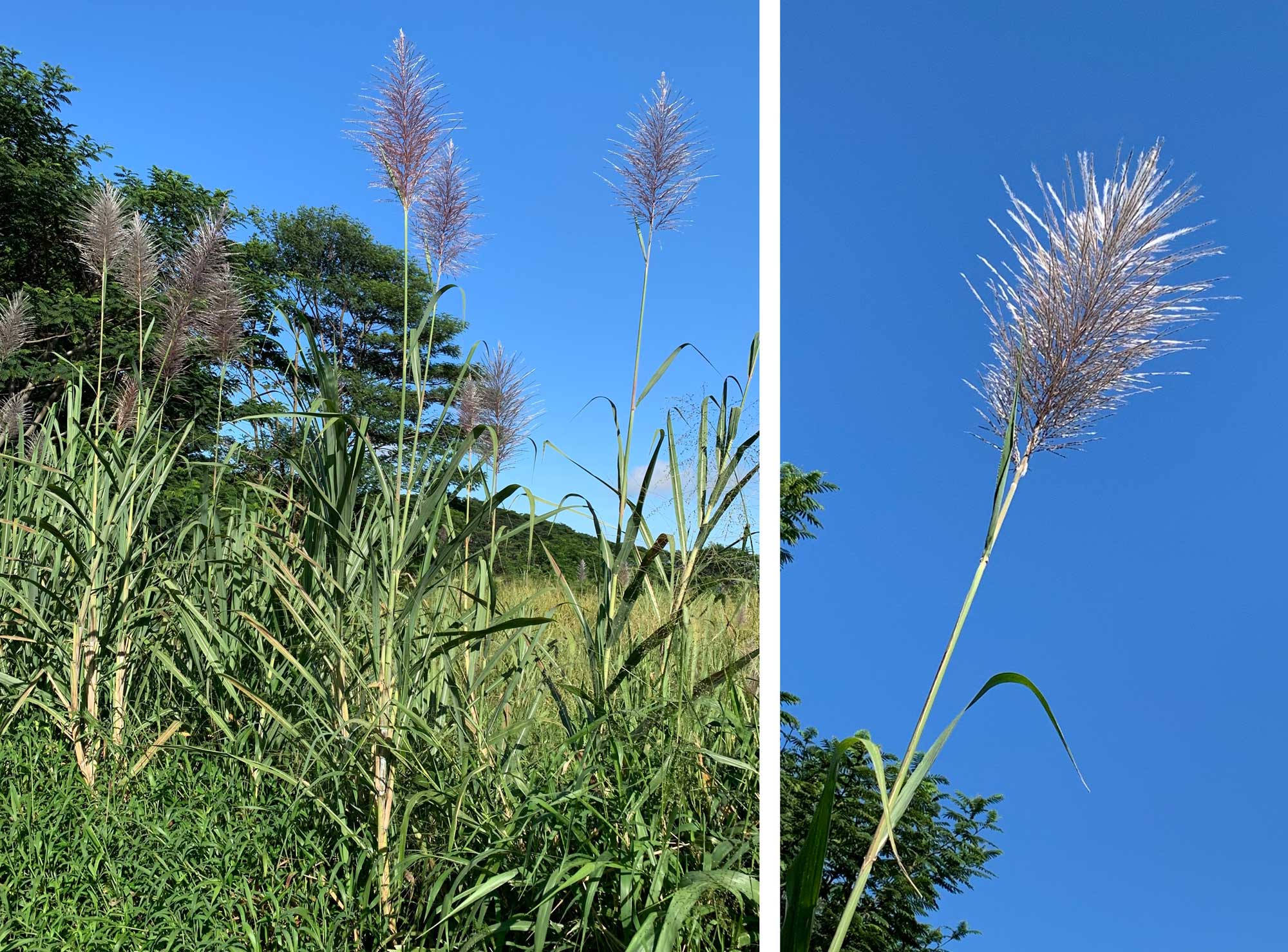
Chinese sugar cane (Saccharum x sinense), Hilo, Hawaii. Left: Plants. Right: Close-up of inflorescence. Photo by matthewt6416 (iNaturalist, Creative Commons Attribution-NonCommercial 4.0 International license, images cropped and resized).
If the two species that form a hybrid are in different genera, then the name for the hybrid can be represented by a hybrid formula or by a combination of a nothogenus name with a nothospecies epithet, with a multiplication sign preceding the nothogenus name. For example, the hybrid formula for Macoun's barley, the hybrid between slender wheatgrass (Elymus trachycaulus) and foxtail barley (Hordeum jubatum), is:
Elymus trachycaulus x Hordeum jubatum
The nothospecies name for the same hybrid is:
x Elyhordeum macounii
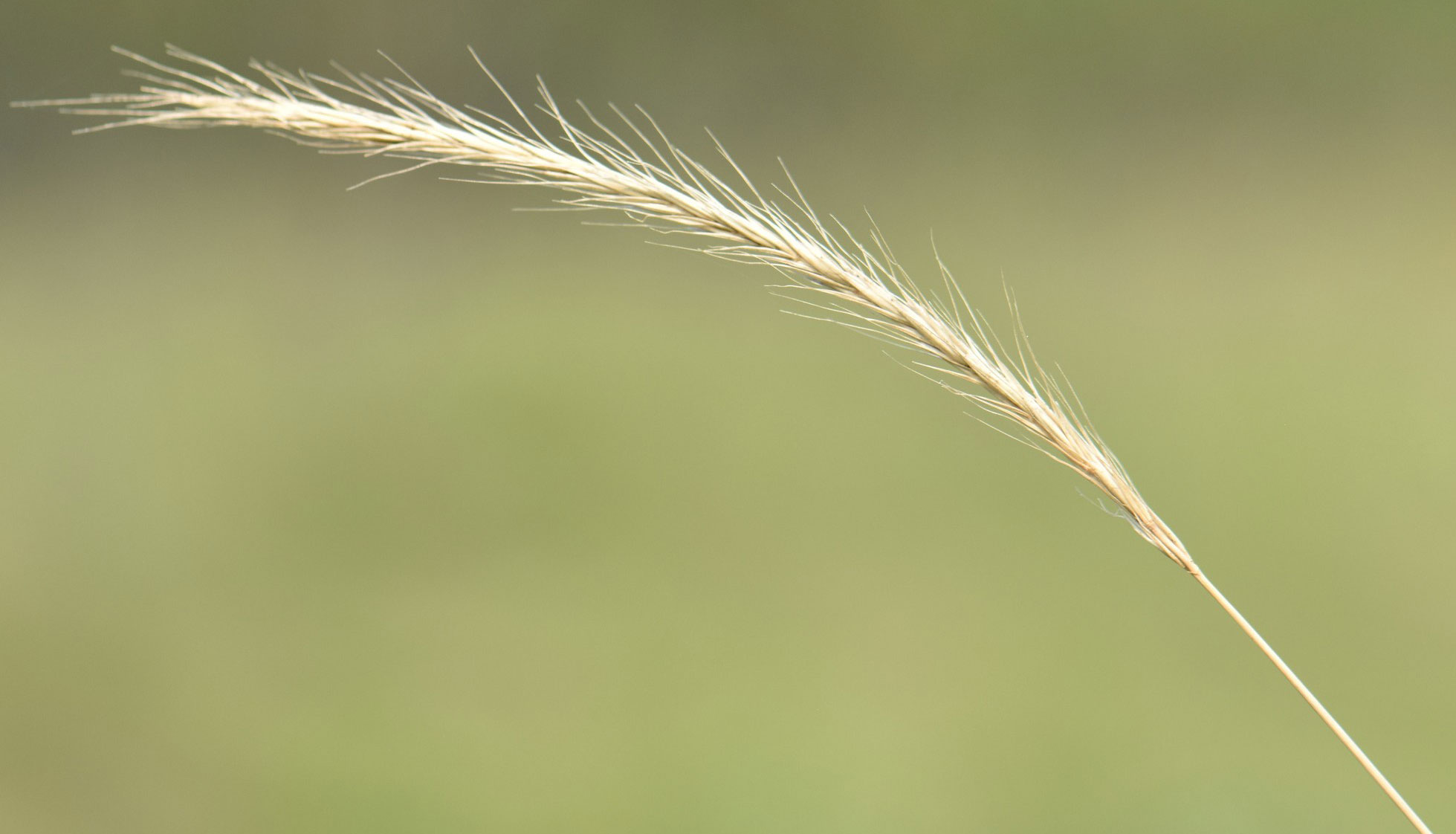
Macoun's barley (x Elyhordeum macounii), Saskatchewan, Canada. Photo by eric-lamb (iNaturalist, Creative Commons Attribution 4.0 International license, image cropped).
Exceptions to hybrid names
In some cases, names of species that are of hybrid origin may not be treated as hybrid or nothospecies names, especially if the hybrid species has functionally become established as its own independent, interbreeding population of plants.
For example, bread wheat (Triticum aestivum) originated as a hybrid. Bread wheat is descended from a hybrid of Tausch's goatgrass (Aegilops tauschii) and domesticated emmer wheat (Triticum dicoccum or Triticum turgidum subsp. dicoccum), which itself originated as a hybrid between Red wild einkorn wheat (Triticum uratu) and goatgrass (Aegilops speltoides var. ligustica). Bread wheat now persists as a stable, independent species that exists only in cultivation. It is treated as neither a nothospecies nor a hybrid, except in discussion of its ancestry.
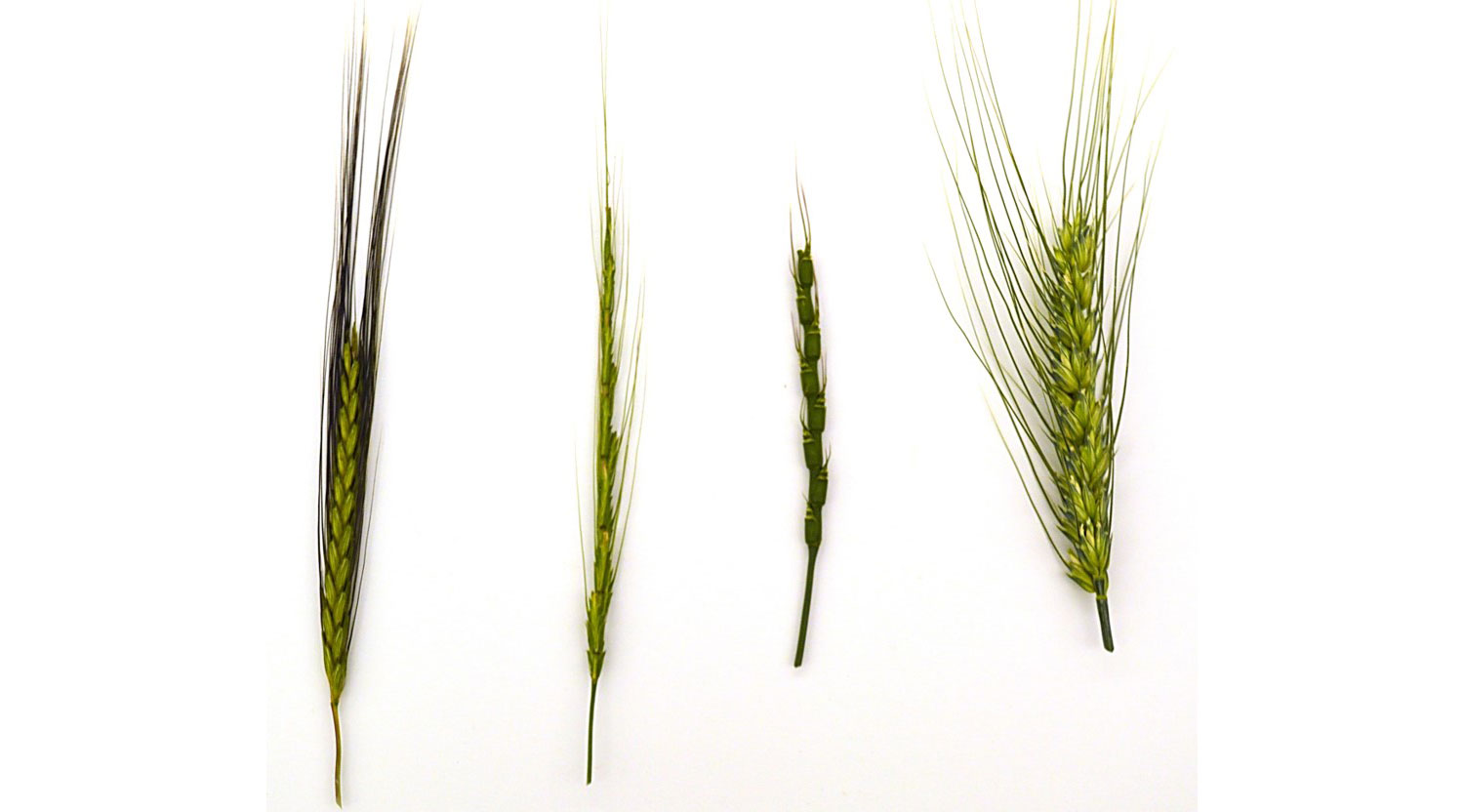
Bread wheat and its ancestors, showing differences in the sizes of the grains. From left to right: Red wild einkorn wheat (Triticum urartu), goatgrass (Aegilops speltoides var. ligustica), Tausch's goatgrass (Aegilops tauschii), and bread wheat (Triticum aestivum). Photo by Pat Byrne (from G. M. Volk and P. F. Byrne, Crop wild relatives and their use in plant breeding. Colorado State University, eBook, public domain).
Cultivar and trade names
Cultivar names
Cultivar names are governed the International Code of Nomenclature for Cultivated Plants. According to the code, a cultivar is made up of plants that share a unique character or set of characters. The character or set of characters that defines a particular cultivar must be "distinct, uniform, and stable." The character or set of characters that define a cultivar must also be consistently present in its offspring when the cultivar is propagated correctly. In practice, it might be necessary to propagate a cultivar asexually to maintain its defining character(s).
A cultivar name is not italicized and should be placed in single quotation marks following the scientific species name. For example, the scientific species name of pampas grass is:
Cortadera selloana
One cultivar of pampas grass has the cultivar name 'Pumila'. The cultivar should thus be written like this:
Cortadera selloana 'Pumila'
In practice, the cultivar name may be paired with the common name for a plant instead of the scientific name, especially when the plant is being sold commercially. Furthermore, the cultivar name may be placed before or following the common name or scientific name for a plant species. For example, the name above could be written as:
Pampas Grass 'Pumila'

Left: Pampas grass (Coraderia selloana). Right: Pampas grass 'Pumila' (Coraderia selloana 'Pumila'). Left photo by Fernando de Gorocica (Wikimedia Commmons, Creative Commons Attribution-ShareAlike 4.0 International license, image cropped and resized); right photo by Ltshears (Wikimedia Commons, Creative Commons Attribution-ShareAlike 3.0 Unported license, image cropped and resized).
Trade names
Trade designations or trade names are names created solely for marketing purposes. Unlike formal cultivar names, trade designations are not in quotes. Trade designations can be trademarked (often indicated by a superscript "R" enclosed in a circle or a superscript "TM" following the name), which restricts their use. Cultivar names cannot be trademarked and may be used by anyone.
Resources
Websites
Additional resources from the Paleontological Research Institution:
Digital Encyclopedia of Ancient Life: Taxonomy
Nomenclatural codes
ICN (formerly ICBN): International Code of Nomenclature for Algae, Fungi, and Plants (Shenzhen Code). 2018. https://www.iapt-taxon.org/nomen/main.php
ICNCP: International Code of Nomenclature for Cultivated Plants, 9th ed. 2016. Scripta Horticulurae 18. https://www.ishs.org/scripta-horticulturae/international-code-nomenclature-cultivated-plants-ninth-edition
Books
Evert, R. F., and S. E. Eichhorn. 2013. Raven Biology of Plants, 8th ed. W.H. Freeman and Company Publishers, New York, New York.
Levetin, P., and D. S. McMahon. 2016. Plants and Society, 7th ed. McGraw Hill Education, New York.
Volk, G. M., and P. F. Byrne. Crop wild relatives and their use in plant breeding. Colorado State University, eBook. https://colostate.pressbooks.pub/cropwildrelatives/front-matter/crop-wild-relatives-and-their-use-in-plant-breeding/
Scientific articles and books
Hammer, K., A. A. Filatenko, and K. Pistrick. 2010. Taxonomic remarks on Triticum L. and xTriticosecale Wittm. Genetic Resources and Crop Evolution 58: 3-10. https://doi.org/10.1007/s10722-010-9590-4



